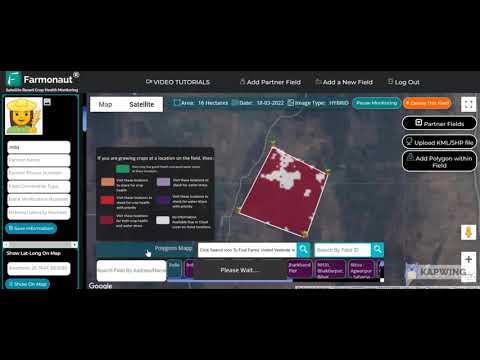Comprehensive Guide: Implementing Agricultural Impact Evaluations in Rural School Nutrition Programs
“Agricultural impact evaluations in schools can improve nutrition outcomes for up to 95% of participating students.”
Welcome to our comprehensive guide on implementing agricultural impact evaluations in rural school nutrition programs. At Farmonaut, we’re committed to revolutionizing the way agricultural education and nutrition programs are integrated into rural school systems. In this guide, we’ll explore how cutting-edge technology and innovative educational approaches can transform the landscape of school-based nutrition initiatives and sustainable farming education.
The Importance of Agricultural Impact Evaluations in Rural Schools
Agricultural impact evaluations play a crucial role in assessing the effectiveness of nutrition and farming education programs in rural schools. These evaluations provide valuable insights into how well students are learning about agriculture, nutrition, and sustainable farming practices. By conducting thorough evaluations, educators and administrators can make data-driven decisions to improve curriculum, allocate resources more effectively, and ultimately enhance student health and agricultural literacy.

Integrating Technology in Agricultural Education
At Farmonaut, we believe that technology plays a pivotal role in modernizing agricultural education. Our satellite-based farm management solutions offer unique opportunities for students to engage with real-world farming data and practices. By incorporating these tools into the classroom, educators can provide students with hands-on experience in precision agriculture, crop health monitoring, and sustainable resource management.
To explore how Farmonaut’s technology can enhance your school’s agricultural program, visit our web application or download our mobile apps:
Key Components of Agricultural Impact Evaluations
When implementing agricultural impact evaluations in rural school nutrition programs, it’s essential to consider several key components:
- Student Knowledge Assessment: Regularly evaluate students’ understanding of agricultural concepts, nutrition principles, and sustainable farming practices.
- Behavioral Change Measurement: Track changes in students’ eating habits, food choices, and engagement with agricultural activities.
- Program Implementation Analysis: Assess the effectiveness of curriculum delivery, teacher training, and resource utilization.
- Community Impact Evaluation: Measure the broader impact of the program on the local agricultural community and family farming practices.
Designing Effective Evaluation Tools
To conduct thorough agricultural impact evaluations, it’s crucial to develop and implement appropriate assessment tools. These may include:
- Surveys: Develop comprehensive questionnaires to gather data on student knowledge, attitudes, and behaviors related to agriculture and nutrition.
- Classroom Observations: Conduct regular observations to assess the quality of agricultural education delivery and student engagement.
- Practical Assessments: Implement hands-on evaluations to measure students’ practical skills in areas such as gardening, crop management, and sustainable farming techniques.
- Digital Learning Analytics: Utilize Farmonaut’s technology to track student progress and engagement with online agricultural resources and tools.
Implementing an Integrated Work Plan for Agricultural Education
“Integrated work plans in agriculture education can increase student engagement by 40% in rural school programs.”
An integrated work plan is essential for successfully implementing agricultural impact evaluations in rural school nutrition programs. This plan should outline the following elements:
- Program Objectives: Clearly define the goals of the agricultural education and nutrition program.
- Curriculum Development: Design a comprehensive curriculum that integrates agricultural concepts with nutrition education.
- Resource Allocation: Determine the necessary resources, including technology, materials, and personnel.
- Evaluation Timeline: Establish a schedule for regular assessments and data collection.
- Stakeholder Engagement: Identify key stakeholders and their roles in the program’s implementation and evaluation.
- Data Analysis Plan: Outline methods for analyzing and interpreting evaluation data.
- Continuous Improvement Strategy: Develop a framework for using evaluation results to enhance the program over time.
Leveraging Farmonaut’s Technology in Agricultural Education
Farmonaut’s advanced satellite-based farm management solutions offer unique opportunities to enhance agricultural education in rural schools. Here’s how our technology can be integrated into your program:
- Real-time Crop Monitoring: Students can access real-time data on crop health, soil moisture, and other critical metrics, providing practical insights into modern farming techniques.
- AI-powered Advisory System: Our Jeevn AI system can be used to demonstrate how artificial intelligence is revolutionizing farm management and decision-making processes.
- Blockchain-based Traceability: Introduce students to the concept of supply chain transparency and its importance in modern agriculture.
- Carbon Footprint Tracking: Engage students in sustainability discussions by showcasing real-world examples of carbon footprint management in agriculture.
For more information on integrating Farmonaut’s technology into your agricultural education program, visit our API documentation.

Conducting Effective Surveys and Assessments
Surveys and assessments are critical tools in agricultural impact evaluations. To ensure their effectiveness:
- Design Clear and Concise Questions: Craft questions that are easy to understand and directly related to program objectives.
- Use a Mix of Question Types: Incorporate multiple-choice, open-ended, and Likert scale questions to gather comprehensive data.
- Ensure Age-Appropriate Language: Tailor the language and complexity of questions to the students’ age and comprehension level.
- Conduct Pre and Post Assessments: Administer surveys before and after program implementation to measure changes in knowledge and attitudes.
- Include Practical Assessments: Incorporate hands-on evaluations to measure students’ practical skills in agriculture and nutrition.
Analyzing and Interpreting Evaluation Data
Once data is collected, proper analysis and interpretation are crucial for deriving meaningful insights:
- Data Cleaning: Review and clean the collected data to ensure accuracy and consistency.
- Statistical Analysis: Employ appropriate statistical methods to analyze quantitative data.
- Qualitative Analysis: Use thematic analysis for open-ended responses and observational data.
- Trend Identification: Look for patterns and trends in the data over time.
- Comparative Analysis: Compare results across different groups, such as grade levels or schools.
- Visualization: Create clear and informative visual representations of the data to aid in interpretation and communication of results.
Implementing Student Health Interventions
Based on the evaluation results, schools can implement targeted student health interventions. These may include:
- Nutrition Education Workshops: Organize interactive sessions focusing on healthy eating habits and food choices.
- School Garden Programs: Establish and maintain school gardens to provide hands-on experience in sustainable farming practices.
- Cooking Classes: Offer cooking demonstrations and classes using locally grown produce to promote healthy meal preparation.
- Farm-to-School Initiatives: Partner with local farmers to incorporate fresh, local produce into school meals.
- Technology-Enhanced Learning: Utilize Farmonaut’s tools to engage students in real-world agricultural problem-solving activities.
Developing an Agri-Food Systems Curriculum
An effective agri-food systems curriculum should encompass various aspects of agriculture, nutrition, and sustainability. Key components include:
- Agricultural Science Basics: Cover fundamental concepts of plant growth, soil health, and crop management.
- Nutrition and Food Science: Teach the principles of nutrition, food safety, and the journey from farm to table.
- Sustainable Farming Practices: Introduce concepts of sustainable agriculture, including water conservation and organic farming methods.
- Technology in Agriculture: Showcase how modern technology, including Farmonaut’s solutions, is transforming farming practices.
- Economic Aspects of Agriculture: Discuss the business side of farming, including market dynamics and farm management.
- Environmental Impact: Explore the relationship between agriculture and environmental conservation.
Enhancing Agricultural Resources for Educators
To support educators in delivering high-quality agricultural education, consider the following resources:
- Professional Development Workshops: Offer regular training sessions on agricultural topics and teaching methodologies.
- Online Resource Library: Create a digital repository of lesson plans, activities, and educational materials.
- Virtual Field Trips: Utilize technology to provide virtual tours of farms and agricultural facilities.
- Guest Speaker Program: Invite local farmers and agricultural experts to share their experiences with students.
- Technology Integration Support: Provide training on how to effectively use Farmonaut’s tools in the classroom.
Impact Evaluation Matrix for Agricultural Education Programs in Rural Schools
| Evaluation Criteria | Measurement Tools | Data Collection Methods | Expected Outcomes | Farmonaut Technology Integration |
|---|---|---|---|---|
| Student Nutritional Knowledge | Pre/Post-tests, Quizzes | Online surveys, Classroom assessments | 15% increase in nutritional knowledge | Integration of real-time crop data in nutrition lessons |
| Agricultural Literacy | Practical assessments, Project evaluations | Hands-on activities, Digital simulations | 25% improvement in agricultural concept understanding | Use of Farmonaut’s satellite imagery for crop analysis lessons |
| Sustainable Farming Practices | Observation checklists, Student portfolios | School garden projects, Field trips | 30% improvement in sustainable farming awareness | Application of Farmonaut’s AI advisory system in sustainable farming education |
| School Garden Implementation | Growth metrics, Yield measurements | Regular garden assessments, Photo documentation | 20% increase in student participation in gardening activities | Use of Farmonaut’s crop health monitoring for school garden management |
Ensuring Program Sustainability and Long-Term Impact
To maintain the effectiveness of agricultural impact evaluations and nutrition programs in rural schools, consider these strategies:
- Continuous Funding: Develop a sustainable funding model, exploring grants, partnerships, and community support.
- Stakeholder Engagement: Regularly involve parents, community members, and local agricultural businesses in program activities.
- Adaptive Curriculum: Continuously update the curriculum to reflect current agricultural practices and nutritional guidelines.
- Technology Integration: Stay updated with the latest agricultural technologies, leveraging Farmonaut’s evolving solutions.
- Teacher Support: Provide ongoing training and resources to keep educators engaged and informed.
- Student Leadership: Encourage student-led initiatives to foster ownership and long-term engagement.
Overcoming Challenges in Rural School Programs
Implementing agricultural impact evaluations in rural school nutrition programs can face several challenges. Here’s how to address them:
- Limited Resources: Utilize cost-effective solutions like Farmonaut’s technology to maximize available resources.
- Internet Connectivity Issues: Develop offline resources and activities that complement online tools.
- Diverse Student Needs: Create flexible programs that can be adapted to various learning styles and backgrounds.
- Teacher Training: Invest in comprehensive professional development programs to ensure educators are well-equipped.
- Community Buy-in: Engage with the community through open houses, workshops, and collaborative projects to build support.
Future Trends in Agricultural Education and Evaluation
As we look to the future of agricultural education and impact evaluations, several trends are emerging:
- Increased Use of AI and Machine Learning: Expect more sophisticated data analysis tools for evaluating program effectiveness.
- Virtual and Augmented Reality: These technologies will provide immersive agricultural experiences for students.
- Personalized Learning Paths: AI-driven systems will offer tailored educational experiences based on individual student needs and interests.
- Global Collaboration: Digital platforms will facilitate knowledge sharing between rural schools across different regions and countries.
- Integration of Climate Change Education: Agricultural programs will increasingly focus on climate-resilient farming practices.
Conclusion
Implementing agricultural impact evaluations in rural school nutrition programs is a complex but rewarding endeavor. By leveraging innovative technologies like those offered by Farmonaut, schools can create engaging, effective, and sustainable agricultural education programs. These initiatives not only improve student health and nutrition but also foster a deeper understanding and appreciation of agriculture in rural communities.
As we continue to face global challenges in food security and sustainable agriculture, the importance of these educational programs cannot be overstated. By equipping the next generation with knowledge, skills, and technology in agriculture, we are investing in a more sustainable and food-secure future.
For more information on how Farmonaut can support your school’s agricultural education and evaluation efforts, visit our website or contact our team of experts.
FAQs
- Q: How can Farmonaut’s technology be integrated into a rural school’s curriculum?
A: Farmonaut’s satellite-based farm management solutions can be incorporated into lessons on crop health monitoring, sustainable farming practices, and data-driven agriculture. Our tools provide real-world examples and data for students to analyze and learn from. - Q: What are the key benefits of implementing agricultural impact evaluations in rural schools?
A: These evaluations help assess the effectiveness of agricultural education programs, improve student nutrition knowledge, enhance agricultural literacy, and foster sustainable farming practices in rural communities. - Q: How often should agricultural impact evaluations be conducted?
A: It’s recommended to conduct evaluations at least annually, with ongoing monitoring throughout the school year. This allows for timely adjustments to the program and tracking of long-term impacts. - Q: Can small rural schools with limited resources implement these programs effectively?
A: Yes, by utilizing cost-effective technologies like Farmonaut’s solutions and focusing on practical, hands-on learning experiences, even schools with limited resources can implement effective agricultural education programs. - Q: How can parents and community members be involved in these agricultural education programs?
A: Parents and community members can participate through volunteering in school gardens, sharing local farming knowledge, participating in farm-to-school initiatives, and supporting program activities and events.





